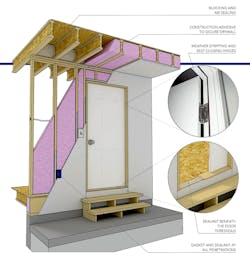Builders know that good air sealing makes a home more comfortable and energy efficient, but with an attached garage it also serves an important health function. That’s because a poorly sealed wall or ceiling between the garage and the main house can let harmful fumes into the living space. These include carbon monoxide from vehicles and natural-draft gas water heaters, as well as VOCs from paints, solvents, and even the lawn mower’s gas can.
But while the International Energy Conservation Code requires air sealing between the garage and the conditioned space, this is an area where we continue to see problems, even when the rest of the house is done right. The problem is that the job of air sealing this space can be more complicated than with other parts of the building enclosure. For one thing, the wall separating the garage and living space will most likely be covered on both sides with drywall, which includes switches and outlets that are often poorly sealed. Another commonly overlooked area is where joists cross the wall between the conditioned space and the garage. Lack of blocking in each joist bay, accompanied by insufficient air sealing, can seriously compromise the air barrier.
Image: IBACOS
Some builders make an airtight separation wall by installing the garage-side drywall, then insulating from the house side with spray polyurethane foam insulation. Others install a motion-sensing exhaust fan in the garage, which can continuously run at low speed and then kick into high when a vehicle or person enters the space. If someone opens the door, the negative pressure created by the fan will ensure that air flows from the house to the garage rather than vice versa. But beware that a fan may not be appropriate for a garage that contains an atmospherically vented water heater, as it could cause back-drafting.
If adding continuous spray polyurethane foam or mechanical ventilation isn’t part of your solution, the following checklist will help ensure that the garage has been properly airsealed and that crews have addressed potential weak spots. The list assumes a garage with conditioned living space above and next to it.
- Make sure the door from the garage to the house has quality weather stripping and self-closing hinges. Apply three thick beads of sealant beneath the threshold.
- Where joists cross the wall between the conditioned space and the garage, install blocking in each joist bay and seal around the blocking with caulk or expanding foam. Acceptable blocking materials include plywood, OSB, and rigid insulation board.
- If the garage shares a slab with the home, use a pliable gasket to seal between the sill plate and the slab on the separation wall.
- Before installing the drywall, use expanding foam to fill gaps around any wire and plumbing penetrations in the wall or ceiling.
- When hanging drywall, use construction adhesive to seal around the edges.
- The water heater platform is a common source of air leakage. Make sure you install and seal the drywall in that area before building the platform.
- Install foam gaskets behind outlets and switch plates, and seal the boxes to the drywall with sealant for extra protection.
- Keep ductwork out of the garage. Even a small leak could draw harmful fumes into the living space.
Richard Baker is program manager of the Builder Solutions Team at IBACOS.
This piece originally ran as part of IBACOS's Quality Matters series.

